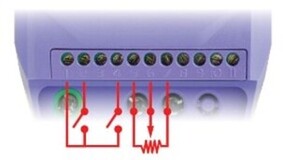EU declaration conformity
Frequency inverter | 7.0 A | 1.5 kW | IP66 | 3ph 230 V
Product description
Variable frequency drive in dust-tight and washdown ready enclosure. It controls fans and pumps with three-phase 230 Volt motors. It is optimised for HVAC applications. This VFD is particularly simple to use. For most applications it is not necessary to change the default settings. The required supply voltage is three-phase 230 Volt.
Various types of three-phase 230 Volt motors can be controlled: IE3 or IE4 induction motors, permanent magnet motors, brushless DC or synchronous reluctance motors. One or multiple motors with a (combined) maximum current of 7.0 A can be controlled by this drive. Motor speed can be set via the intuitive keypad or via the inputs. Configuration is simplified via 14 basic parameters and application macro functions.
The enclosure can be DIN rail mounted in an electrical cabinet. It offers an IP66 protection against ingress of water and dust. The integrated EMC filter is Class C1.
Manufacturers code: ODE-3-220070-3F4A.
Documents
Additional specifications and description
The combination of a three-phase powered frequency inverter and a three-phase motor is generally more efficient and practical compared to a single-phase variant. A mains voltage of three-phase 230 Volt is not so common in industrial installations, but rather in residential environments. This makes this frequency inverter extremely suitable for controlling fans or pumps in HVAC applications. On top of that, it is also extremely user-friendly. In many applications, the default settings can be retained and the frequency inverter can be put into use immediately after installation.
IP66 enclosure for outdoor surface mounting
The wall-mounting enclosure is designed to protect the electronics in harsh environments as well as in outdoor applications. It offers an IP66 protection against the ingress of water, dirt and contaminants. This makes it possible to install this frequency inverter directly on the installation, even in wash-down applications. It eliminates the need of an electric cabinet. It is advisable to protect the device against snow and direct sunlight.
Easy to use

By selecting one of these application macros, the most important settings are pre-configured automatically. It saves you to define the functionality for the different inputs. These functionalities are pre-defined in the application macros. These default settings are sufficient for many applications. Typical applications are AC fans, blowers, centrifugal pumps, fume extractors and air flow controllers.
By default, input 1 is used to start the motor. An optional 10K potentiometer can be connected to terminals 5, 6 and 7 to adjust fan speed.
When input 3 is activated, the motor runs at the predefined speed in parameter 20. When input 3 is not activated (or not connected), the motor speed can be adjusted via the external potentiometer (or analogue control signal).
Pulse-width modulation
Frequency inverters control motor voltage and motor frequency via a technology called pulse-width modulation. This technology converts the supplied AC voltage into DC voltage. A frequency inverter has a DC bus, which can be seen as a buffer tank for the available energy. This buffer tank is filled both by the supply voltage (via the rectifier) and by regenerative energy from the motor that flows back during braking. This DC voltage is converted back into a kind of alternating voltage by IGBTs. IGBTs or Insulated Gate Bipolar Transistors are bipolar transistors with an insulated gate terminal that can switch high electrical current at high speed. Thanks to the smart control of the IGBTs, both the motor voltage and the motor frequency can be controlled. This enables optimum motor control and energy-efficient operation. This frequency inverter requires a single-phase 230 V power supply. It controls standard 3-phase 230 V IE2, IE3 and IE4 induction motors. On top of that, it can also control Permanent Magnet motors, Brushless DC Motors and Synchronous Reluctance Motors.
Standard built-in EMC filter class C1
A disadvantage of high-frequency switching IGBTs is the fact that they pollute the electrical network with higher harmonic interference signals (EMC pollution). To minimize this network pollution, an EMC filter class C1 is built in as standard. This blocks the pollution and reduces interferences with other electronic devices installed in the surrounding area. However, the EMC filter only is not sufficient to eliminate all interferences. In addition to the EMC filter, correct installation and wiring are required to minimize interferences. Power cables should always be separated from signal and network cables.





Remarks, reviews & ratings